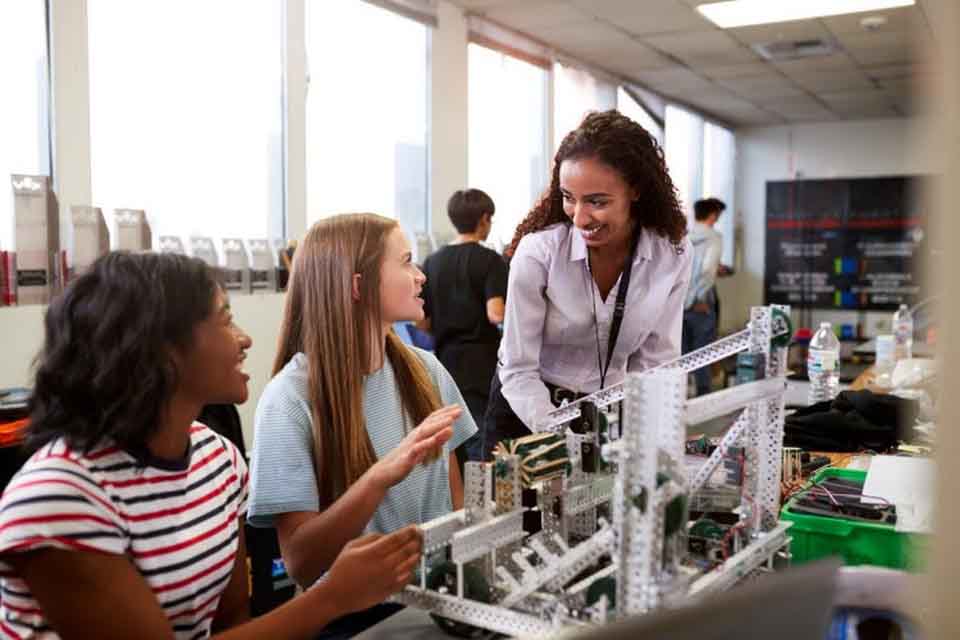Building a gingerbread house, creating a robot, baking cookies—all of these are ways maker education can be implemented in the classroom. What is maker education? It’s the concept of using hands-on activities to support learning, according to Education Week. From robotics to coding, 3D printing to model building, maker education is transforming education in countless ways.
What is Maker Education?
Maker education is an approach to learning that centers students’ interests and directs them to an awareness of design. Approach, mindset, and community are core fundamentals of maker education, according to Maker Ed. The approach is less about the final product and more about what a student learns while making it. The physical lessons students learn can expand to theories surrounding the world, communities, resilience, innovation, and knowledge sharing. Maker education encourages students to continually think about designs in the world and to constantly improve them.
Maker education originated in the maker movement, sparked by Make magazine, which Dale Dougherty launched in 2005. The magazine catalyzed a community of do-it-yourself, technology-driven individuals, according to Maker Faire. The key to the movement’s growth lies in accessibility. Innovative technologies are now more affordable than ever to the public. The internet allows everyone to share knowledge and ideas in an instant, promoting the globalization of makers and problem-solving. More recently, new products and services have emerged, and technologies such as 3D printing, robotics, augmented reality (AR), and new programming languages have thrust the maker movement into education.
Today, educators explore design with their students, allowing them to find solutions and work without explicit instruction. According to the International Society for Technology in Education (ISTE), the three most common ways students explore design in the classroom are as follows:
- Fabrication (3D printing, laser cutting, etc.)
- Computing (robotics)
- Programming (coding, computer-based modeling, etc.)
Benefits of Hands-On Learning
Theorists Jean Piaget and Seymour Papert explored how hands-on education allowed students to expand their learning through interactive, open-ended, student-driven, multidisciplinary experiences, according to Maker Ed. In the decades since their work, studies have shown that letting students create leads to better academic outcomes.
Through hands-on learning—maker education’s premise—students are shown to have improved retention, attentiveness, and experimentation, according to Build Your Future.
Retention
The first benefit of hands-on learning is an increase in information retention. Studies show that hands-on learning better engages both sides of the brain, leading to stronger neural connections and the ability to store more information. One study compared test scores of students who sat in a lecture about water quality with those who built a water purifier; the latter group tested higher.
Attentiveness
Hands-on learning also improves students’ attentiveness. The interest generated by creating and moving rather than sitting behind a desk allows students to care about a project more. When students are more excited, they’re more willing to learn new concepts. An Association for Career and Technical Education (ACTE) study found that 81 percent of high school dropouts said they would have been more likely to stay in school with hands-on, real-world activities to work on.
Experimentation
Finally, hands-on learning allows students to experiment, exploring new areas rather than learning from a lecture. This can help them discover interests that can lead to a career. Students can also gain better understanding of their strengths and weaknesses through trial and error.
Maker Project Examples
Maker projects can be incorporated into curricula and conducted in classroom settings in many ways.
Project 1: Closing Circuits
Meredith Cosier taught her class of kindergarteners physical computing to introduce them to computer science. With a Makey Makey board—a microcontroller that connects to a computer and interacts with the Makey Makey online apps—she had her students make music. The ultimate lesson: circuits.
Using the Makey Makey piano app, Cosier had her students give each other high fives while holding the controllers, whose metallic clips create electrical connections. As they did, music played on the app: the circuits had closed, sending an electrical signal to the app to play a note. Through closing the circuits, students learned how to make the electrical connections, a concept that may have been too complex to explain to kindergartners otherwise.
Project 2: 3D Printing
In Edutopia, Lauren Huddleston reported her experiences helping students learn about symbolism in literature through 3D printing. After reading The Giver, in which the protagonist becomes the only person in a society with memories and the only one who sees in color, students designed and printed a half-gray, half-red apple to symbolize the character’s transformation as he gained new knowledge about the world in his new role as receiver of memories.
While this class used a 3D printer, others have used Tinkercad: a free learning platform that lets users combine shapes and move objects on a 3D plane.
Lead the Transformation of Education
Visit American University’s School of Education to learn how our programs promote the latest pedagogical methods and practices. The school’s online Masters in Education Policy and Leadership and online Master of Arts in Teaching programs focus on the future of education, teaching individuals how to make lasting change. Discover how to lead innovation in education at American University.
Build Your Future, “Is Hands-On Learning Better?”
Education Week, “‘Physical Computing’ Connects Computer Science With Hands-On Learning”
Edutopia, “Using a Makerspace for English and Humanities Instruction”
International Society for Technology in Education, “The Maker Movement: A Learning Revolution”

